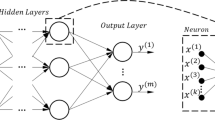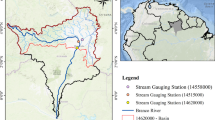Abstract
We propose the application of pruning in the design of neural networks for hydrological prediction. The basic idea of pruning algorithms, which have not been used in water resources problems yet, is to start from a network which is larger than necessary, and then remove the parameters that are less influential one at a time, designing a much more parameter-parsimonious model. We compare pruned and complete predictors on two quite different Italian catchments. Remarkably, pruned models may provide better generalization than fully connected ones, thus improving the quality of the forecast. Besides the performance issues, pruning is useful to provide evidence of inputs relevance, removing measuring stations identified as redundant (30–40% in our case studies) from the input set. This is a desirable property in the system exercise since data may not be available in extreme situations such as floods; the smaller the set of measuring stations the model depends on, the lower the probability of system downtimes due to missing data. Furthermore, the Authority in charge of the forecast system may decide for real-time operations just to link the gauges of the pruned predictor, thus saving costs considerably, a critical issue in developing countries.








Similar content being viewed by others
Notes
In [8] it is also pointed out that, among neuroscientists, such an approach is currently contradicted by “constructivism” [11], which describes the brain development as an increase, rather than a decrease, in the number of synapses. Constructive neural networks algorithms (see for instance [12]), which start with a small network and grow the network until a satisfactory is found, may be interpreted as implementing constructivism in artificial neural networks.
The toolbox is freely available on the Internet: http://www.iau.dtu.dk/research/control/nnsysid.html
References
Maier HR, Dandy CG (2000) Neural networks for the prediction and forecasting of water resources variables: a review of modelling issues and applications. Environ Mod Soft 15:101–124
Hsu VK, Gupta S, Sorooshian S (1995) Artificial neural network modeling of the rainfall runoff process. Water Resour Res 31(10):2517–2530
Shamseldin AY, O’Connor KM, Liang KM (2001) Methods for combining the outputs of different rainfall-runoff models. J Hydrol 245:196–217
Reed R (1993) Pruning algorithms-a survey. IEEE Trans Neural Netw 4(5):740–747
Henrique HM, Lima EL, Seborg DE (2000) Model structure determination in neural network models. Chem Eng Sci 55(22):5457–5469
García-Gimeno R, Hervás-Martínez C, de Silóniz MI (2002) Improving artificial neural networks with a pruning methodology and genetic algorithms for their application in microbial growth prediction in food. Int J Food Microbiol 72(1–2):19–30
Poppi RJ, Massart DL (1998) The optimal brain surgeon for pruning neural network architecture applied to multivariate calibration. Anal Chim Acta 375(1–2):187–195
Quinlan PT (1998) Structural change and development in real and artificial neural networks. Neural Netw 11:577–599
Edelman G (1987) Neural Darwinism: the theory of neuronal group selection. Basic Books, New York
Changeux J-P, Courrége P, Danchin A (1973) A theory of the epigenesis of neuronal networks by slective stabilisation of synapses. Proc Natl Acad Sci USA 70(10):2974–2978
Quartz SR, Sejnowski TJ (1997) The neural basis of cognitive development: a constructivist manifesto. J Behav Brain Sci 45:35–41
Moody J, Antsaklis PJ (1996) The dependence identification neural networks construction algorithm. IEEE Trans Neural Netw 7:3–15
Liong SY, Lim WH, Paudyal GN (2000) River stage forecasting in Bangladesh: neural network approach. J Comput Civil Eng 14(1):1–8
Kim G, Barros AP (2001) Quantitative flood forecasting using multisensor data and neural networks. J Hydrol 246:45–62
Campolo M, Andreussi P, Soldati A (1999) River flood forecasting with a neural network model. Water Resour Res 35(4):1191–1197
Inc MathWorks (2000) System identification toolbox user guide
Bishop CM (1995) Neural networks for pattern recognition. Oxford University Press, Oxford
Haykin S (1995) Neural networks: a comprehensive foundation. Macmillan Coll, New York
Le Cun Y, Kanter I, Solla S (1991) Eigenvalues of covariance matrices: application to neural network learning. Phys Rev Lett 14(1):2396–2399
Girosi F, Jones M, Poggio T (1995) Regularization theory and neural networks architectures. Neural Comput 7:219–269
Hertz J, Krogh A, Palmer RG (1991) Introduction to the theory of neural computation. Addison Wesley, Reading
Le Cun Y, Denker JS, Solla SA (1990) Optimal brain damage. In: Touretzky DS (ed) Advances in neural information processing systems, vol 2. Morgan Kaufmann, San Francisco, pp 598–605
Hassibi B, Stork DG (1993) Second order derivatives for network pruning: optimal brain surgeon. In: Giles CL, Hanson SJ, Cowan JD (eds) Proceedings of advances in neural information processing system, pp 164–171
Norgaard M, Ravn O, Poulsen NK, Hansen LK (2000) Neural networks for modelling and control of dynamic systems. Springer, London
Norgaard M (2000) Neural network based system identification toolbox. Technical Report 00-E-891, Department of Automation, Technical University of Denmark
Chang FJ, Liang J, Chen Y (2001) Flood forecasting using radial basis function neural networks. IEEE Trans Syst Man Cybern C 31(4):530–535
Zampaglione (1995) Progetto di massima per il riequilibrio idraulico ambientale del fiume Olona: Relazione Idrologica
Corani G, Guariso G (2001) Stocasthic models for flood forecasting on rivers Brembo and Olona. Technical Report 2001.50, Department of Electronics and Information, Polytechnic of Milan
Acknowledegments
The authors thank M. Molari and N. Quaranta, Civil Protection Service of the Lombardy Region, for supplying the data of the Olona river, M. Campolo and A. Soldati, University of Udine, for the data of the Tagliamento river.
Author information
Authors and Affiliations
Corresponding author
Rights and permissions
About this article
Cite this article
Corani, G., Guariso, G. An application of pruning in the design of neural networks for real time flood forecasting. Neural Comput & Applic 14, 66–77 (2005). https://doi.org/10.1007/s00521-004-0450-z
Received:
Accepted:
Published:
Issue Date:
DOI: https://doi.org/10.1007/s00521-004-0450-z




